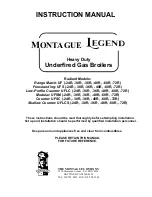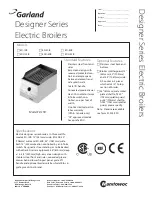
25
V. GAS PIPING
Table 5: Gas Ratings
For materials or conditions other than those listed
above, refer to
National Fuel Gas Code
, ANSI Z223.1 /
NFPA54, CAN/CSA B149.1
Natural Gas and Propane
Installation Code
or size system using standard
engineering methods acceptable to authority having
jurisdiction.
Table 6: Specific Gravity Correction Factors for
Natural Gas
WARNING
Failure to properly pipe gas supply to boiler may
result in improper operation and damage to the
boiler or structure. Always assure gas piping is
absolutely leak free and of the proper size and
type for the connected load.
An additional gas pressure regulator may be
needed. Consult gas supplier.
A.
Size gas piping
. Design system to provide adequate gas
supply to boiler. Consider these factors:
1. Allowable pressure drop from point of delivery to
boiler. Maximum allowable system pressure is ½
psig. Actual point of delivery pressure may be less;
contact gas supplier for additional information.
Minimum gas valve inlet pressure is stamped on
the rating label located in the boiler’s vestibule
compartment.
2. Maximum gas demand. Refer to the boiler’s input as
printed on its rating label. Also consider existing and
expected future gas utilization equipment (i.e. water
heater, cooking equipment).
3. Length of piping and number of fittings. Refer to
Table 7 for maximum capacity of Schedule 40 pipe.
Table 8 lists equivalent pipe length for standard
fittings.
4. Corrections for the specific gravity of natural gas
can be found in Table 6.
Specific
Gravity
Correction
Factor
Specific
Gravity
Correction
Factor
---
---
0.85
0.81
---
---
0.90
0.82
0.60
1.00
1.00
0.78
0.65
0.96
1.10
0.74
0.70
0.93
1.20
0.71
0.75
0.90
1.30
0.68
0.80
0.87
1.40
0.66
Model
Natural /LP
Maximum
Gas Pressure
(in. w.c.)
Minimum Natural
Gas Pressure
(in. w.c.)
Inlet to Gas Valve
Minimum LP
Gas Pressure
(in. w.c.)
Inlet to Gas Valve
Natural Gas
Manifold
Pressure
(in. w.c.)
LP Gas
Manifold
Pressure
(in. w.c.)
PVG3
14
4.5
11.0
3.5
10.0
PVG4
PVG5
PVG6
PVG7
PVG8
PVG9
NOTICE
PVG boilers built for altitudes greater than 4,999 feet above sea level do not need to be specially orificed
for applications up to 10,000 feet. The PVG boiler “H” Model has been certified to operate in atmospheric
conditions from 5,000 to 10,000 feet above sea level. Input is naturally derated approximately 2% per every
1000 feet above sea level.
The PVG boiler is available in two (2) altitude Models: The “S” Model 0 to 4,999 feet above sea level, and the
“H” Model 5,000 to 10,000 feet above sea level.
For applications above 10,000 feet, please follow recommendations in current version of NFPA 54.
Summary of Contents for PVG3
Page 14: ...14 Figure 4 Horizontal Vent Installation III Venting continued...
Page 16: ...16 Figure 7 Attic Offset Figure 6 Vertical Vent Installation III Venting continued...
Page 29: ...29 Figure 17 Wiring Connection Diagram VI Electrical continued...
Page 31: ...31 Figure 19 Circulator Zoned System Wiring Diagram VI Electrical continued...
Page 32: ...32 Figure 20 Zone Valve Zoned System Wiring Schematic VI Electrical continued...
Page 34: ...34 Figure 21 Modular Boiler Piping VII Modular Installation continued...
Page 36: ...36 Figure 22 Operating Instructions VIII System Start up continued...
Page 51: ...51 Figure 29 Flue and Burner Cleanout 1 Burner XI Service continued...
Page 54: ...54 XII Repair Parts continued...
Page 56: ...56 XII Repair Parts continued...
Page 60: ...60 XII Repair Parts continued...
Page 67: ...67 SERVICE RECORD DATE SERVICE PERFORMED...
Page 68: ...68 U S Boiler Company Inc P O Box 3020 Lancaster PA 17604 1 888 432 8887 www usboiler net...
















































